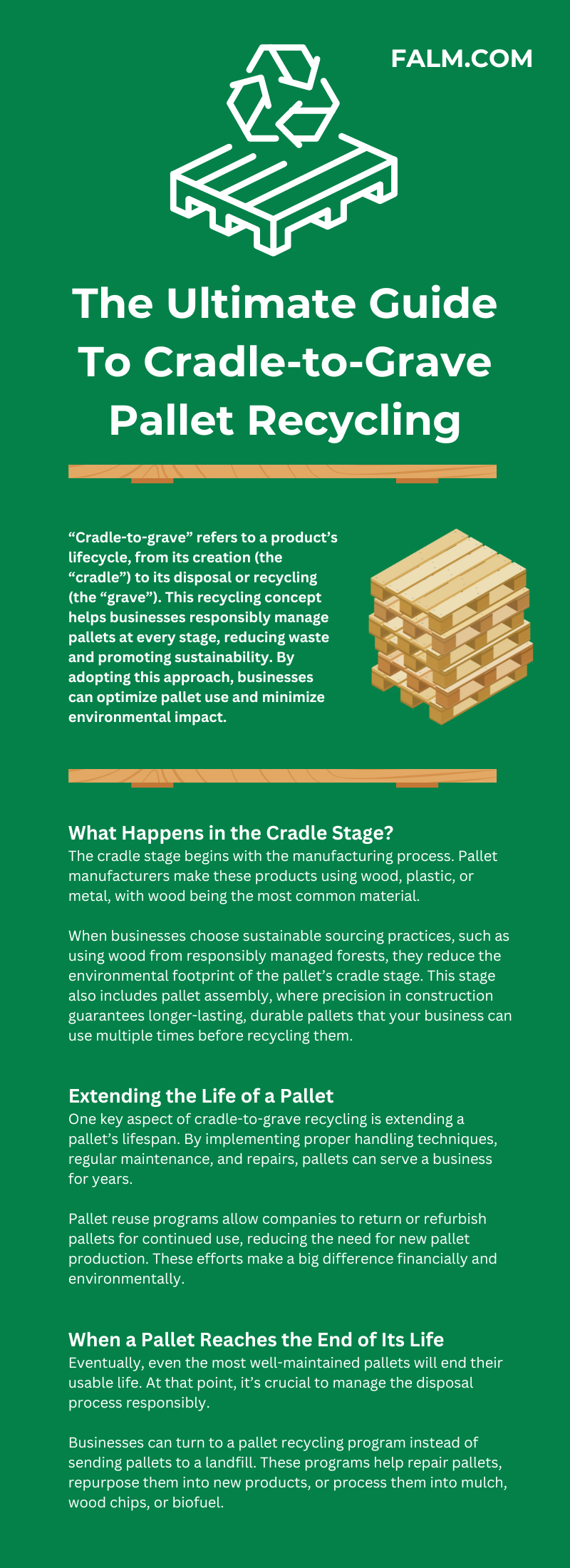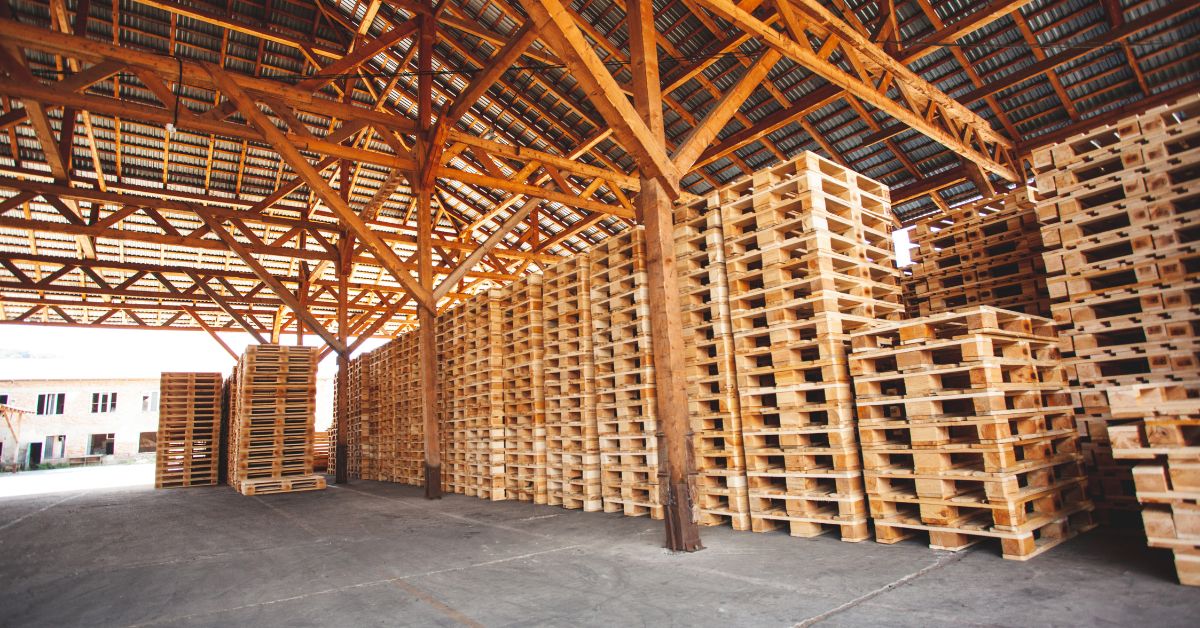Pallets are an essential component of modern logistics, supporting the movement of goods across industries. However, sustainably managing these pallets can be challenging.
This logistical problem creates an opportunity for cradle-to-grave recycling, a comprehensive approach to handling pallets throughout their lifecycle. In this ultimate guide to cradle-to-grave recycling, we’ll explore the ins and outs of this important process. Business owners and logistics managers will receive valuable insights on implementing a sustainable pallet recycling program.
Understanding Cradle-To-Grave Recycling
“Cradle-to-grave” refers to a product’s lifecycle, from its creation (the “cradle”) to its disposal or recycling (the “grave”). This recycling concept helps businesses responsibly manage pallets at every stage, reducing waste and promoting sustainability. By adopting this approach, businesses can optimize pallet use and minimize environmental impact.
The Importance of Pallet Recycling
Pallets often represent a significant portion of a company’s waste, but with proper recycling practices, a company can repurpose, reuse, or recycle them into new materials. Recycling pallets reduces the demand for new wood, decreases landfill waste, and conserves resources. It also saves companies money by reducing the need to purchase new pallets and lowering waste disposal costs.
What Happens in the Cradle Stage?
The cradle stage begins with the manufacturing process. Pallet manufacturers make these products using wood, plastic, or metal, with wood being the most common material.
When businesses choose sustainable sourcing practices, such as using wood from responsibly managed forests, they reduce the environmental footprint of the pallet’s cradle stage. This stage also includes pallet assembly, where precision in construction guarantees longer-lasting, durable pallets that your business can use multiple times before recycling them.
Extending the Life of a Pallet
One key aspect of cradle-to-grave recycling is extending a pallet’s lifespan. By implementing proper handling techniques, regular maintenance, and repairs, pallets can serve a business for years.
Pallet reuse programs allow companies to return or refurbish pallets for continued use, reducing the need for new pallet production. These efforts make a big difference financially and environmentally.
When a Pallet Reaches the End of Its Life
Eventually, even the most well-maintained pallets will end their usable life. At that point, it’s crucial to manage the disposal process responsibly.
Businesses can turn to a pallet recycling program instead of sending pallets to a landfill. These programs help repair pallets, repurpose them into new products, or process them into mulch, wood chips, or biofuel.
Benefits of Pallet Recycling Programs
A recycling program is an organized effort to manage used pallets sustainably. Businesses that participate in such programs enjoy several benefits.
First, they reduce waste disposal costs by diverting pallets from landfills. Second, they contribute to environmental sustainability by conserving natural resources. Third, they can potentially generate revenue by selling recycled materials. By adopting a pallet recycling program, companies take a significant step toward greener operations.
Pallet Recycling: Reviewing Your Current Practices
Businesses must assess their current pallet usage and disposal methods before implementing a recycling process. By conducting a pallet audit, you can identify how many pallets your business uses daily, how often workers discard them, and their condition when removed from the supply chain.
Once you have this information, you can establish a recycling process by partnering with a third-party pallet recycler or creating an internal recycling system. Many pallet recyclers offer pick-up services, making it easy for businesses to participate in sustainable disposal.
Finding the Right Pallet Recycling Partner
Working with the right partner is vital to the success of a cradle-to-grave recycling program. Look for pallet recyclers who have established environmental practices, a range of recycling options, and clear reporting on pallet reuse or recycling outcomes. Many recyclers also offer custom programs that they can tailor to your logistical needs, helping you maximize the efficiency and benefits of your recycling efforts.
Common Pallet Recycling Methods
A recycling partner can use several methods to recycle pallets. Some of the most common methods include:
- Repair and reuse. A pallet recycling partner will fix and put your damaged pallets back into circulation, extending their lifespan.
- Material recovery. You may come across unusable pallets that you can break down into parts or materials. A recycling partner can create new pallets or other products using these materials.
- Mulching and biofuel. A pallet recycling partner can process unusable wooden pallets and turn them into mulch or biofuel, reducing waste.
By understanding these methods, businesses can choose the best recycling strategy for their needs. A partner like First Alliance Logistics Management can help you assess your current strategy and identify the right path forward.
The Environmental Impact of Pallet Recycling
When businesses implement pallet recycling programs, they make a measurable impact on the environment. Recycling pallets reduces deforestation, conserves resources, and lowers carbon emissions from producing new pallets.
Additionally, recycling keeps pallets out of landfills, where they would contribute to the growing waste problem. Companies can create a more sustainable future for the logistics industry by opting for cradle-to-grave pallet recycling.
How Pallet Recycling Saves Money
In addition to environmental benefits, pallet recycling can lead to significant cost savings for businesses. By participating in a pallet recycling program, companies reduce the need to purchase new pallets, lower disposal fees, and potentially earn revenue from recycled materials.
Furthermore, recycling reduces the costs associated with environmental compliance, as businesses that engage in sustainable practices face fewer regulatory challenges and fees.
Encouraging a Culture of Sustainability in Your Business
Implementing cradle-to-grave pallet recycling goes beyond operational efficiency—it encourages a culture of sustainability within your organization.
Businesses can align their operations with modern sustainability goals by promoting recycling practices and educating employees about the benefits of reducing waste. These steps will improve the company’s reputation and boost employee morale, as workers take pride in contributing to environmental responsibility.
Cradle-to-Grave Pallet Recycling With First Alliance Logistics Management
As we’ve discussed, cradle-to-grave pallet recycling offers immense benefits for businesses and the environment. By adopting this comprehensive approach, companies can extend the life of their pallets, reduce waste, and contribute to sustainability efforts.
Implementing a pallet recycling program helps businesses save money while fulfilling their environmental responsibilities. With the right processes and partners, cradle-to-grave pallet recycling can be a simple and effective part of your business operations.
We hope our ultimate guide to cradle-to-grave pallet recycling inspires your business to review its conservation practices. Call First Alliance Logistics Management at (866) 621-6592 to discuss how we can help your business cut down on wasted materials.


